Nathaniel Nelson / Winonan
Winona State University’s technology department upgraded the university’s Adobe programs from the 2013 version to the 2015 version earlier this month, despite the growing cost of a full site license.
Adobe is the developer of the Adobe Creative Cloud that includes creative applications such as Photoshop, InDesign, Premiere, Illustrator and After Effects. At Winona State, students in various departments, especially mass communications and art, use these programs to make creative pieces both for class and their portfolio.
Kenneth Janz, associate vice president for academic affairs and chief information officer at Winona State, was in charge of the negotiations with Adobe.
The main benefit from the upgrades, aside from additional features inside each one, is compatibility with Windows 10, according to Janz.
While having the Adobe programs is integral for many students, Janz said Adobe is making it more difficult to afford the newest products.
“They have a good product, which they know certain disciplines absolutely need. I actually had one of the salesperson say, ‘Well if you don’t get Photoshop, what else are you going to get?,’” Janz said.
According the Janz, the site license cost for Adobe Creative Cloud jumped from $33,000 a year to over $140,000, a more than 300 percent increase. This price jump has caused problems for the university budget, as they have had to find ways to cover the difference.
“We used to spend almost [165,000] to 180,000 a year on classrooms. Now we’re down to a hundred thousand,” he said.
This has led Janz and Winona State to look into changing its licenses from a site license to individual licenses. If this were to happen, it would mean the only students who could download the programs would be students in departments that need them.
As of now, everyone on campus can download and use them at will.
While that may sound like a huge change, in terms of actual downloads, it is in fact quite minor. According to Janz, there are less than 500 computers at Winona State with Photoshop installed, which is the highest Adobe install base.
For comparison, the site license covers every student at Winona State and the Rochester campus.
“I’ve told Adobe that we need to have better pricing, or we’re not going to get a site license anymore,” Janz said. “We’ll have something for students, it’s how broadly available which will be the issue.”
At retail, the creative cloud costs $599.88 a year. For students, these programs, along with many others are included in the laptop fee of $450 that students pay each semester.
“Students complain about the laptop program if they look at it very narrowly,” Winona State mass communications professor Thomas Grier said. “But you’re not getting just a laptop. You’re getting the great service and support. If the machine breaks, you get a new one in 45 minutes, and you get all the software and software updates for free.”
Grier has been using Adobe products since its beginning, and for some programs, even earlier.
In the late 1980s, publication design courses used a program called Aldus Pagemaker to do newspaper layouts, he said. This program eventually became InDesign, which is now an integral part of the mass communications program.
Over the years, the company has grown their creative cloud to be something of a tour-de-force in the creative world, as well as the professional standard.
“We must train our students on this software, or they won’t be able to get jobs,” Grier said.
“Every mass comm student will use Photoshop extensively and InDesign extensively.”
Grier added those in the transmedia option will also use Premiere heavily.
It is also not as simple as just learning one version of the program either, Grier added. When students leave Winona State to look for jobs, it is imperative for them to know the most recent versions, and know them well.
“I think it’s very important for education institutions to try to use the most recent hardware and software. We’re trying to teach students the newest equipment to use to do your job the best it can be,” Grier said. “Where else in an educational environment shouldn’t we have the most recent stuff for students to work with?”
Grier said while the cost might be high, having the programs is more important. Price hikes to fees are rarely well-received, but if those kinds of changes are necessary, then the university should make the change, he said.
“If we’re collecting 450 [dollars] from students, and it’s not enough to give them all the best stuff they need, then take the price up and make it 475 [dollars] or make it 480 [dollars],” he said. “We’ve got to have that stuff available.”








































